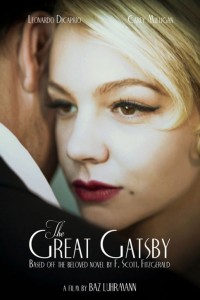I knew a Jay Gatsby.
 We were in grade school in Fort Smith, Arkansas, and stayed close through high school. It probably wasn’t until junior high when I saw this trait of his — simply put it’s a person sure he can buy friends with money. But that is so simple it sounds sociopathic, when it’s the most natural impulse, encouraged by the praise heaped generally on the virtue of generosity. I’ve spotted it in other people, either full-onset or the tendency.
We were in grade school in Fort Smith, Arkansas, and stayed close through high school. It probably wasn’t until junior high when I saw this trait of his — simply put it’s a person sure he can buy friends with money. But that is so simple it sounds sociopathic, when it’s the most natural impulse, encouraged by the praise heaped generally on the virtue of generosity. I’ve spotted it in other people, either full-onset or the tendency.
I don’t recall tying the personality to the classic novel by F. Scott Fitzgerald any time that I have read it or the several times I’ve attempted to sit through the earnest Robert Redford vehicle. But the reality of the psychological impulse is obvious in the unusual yet successful approach taken by director and co-screenwriter Baz Luhrmann.
The Great Gatsby is a great motion picture this spring.
Those who criticize it, those I’ve read at any rate, have a film shot in their minds from the vivid but reflective little book, and this isn’t it.
The volume is quiet, a noisy story told in hindsight by the third wheel, Nick Carraway — the other wheels being Gatsby and Daisy Buchanan, Nick’s cousin whom Jay loves but whom World War I and ambition separated.
This movie is loud, with decidedly non-Jazz Age music used. Maybe music written 80-90 years later would be jarring to reviewers with sensibilities as tender is the night.
I’m not sure how rap star Shawn “Jay-Z” Carter, who scored the film, succeeds, but he blends the latest pop tunes with standards written by Gershwin and others of the 1920s — some “performed” by a lookalike of a young Cab Calloway, (Gershwin modeled the drug dealer Sportin’ Life in his Porgy and Bess on the bandleader).
The musical smorgasbord gives authenticity, not to the times but to the timeless story of youth and lust and love and greed. This most American novel is taught as having painted unique Yankee characters, especially that coming out of the 19th century, but Charles Dickens or Victor Hugo would’ve known them.
Mad Men’s Don Draper is very much this century’s Jay Gatsby, set a half-century ago. We may see ourselves most clearly with a little distance.
If Gatsby the book is a classic it is because of the eternalness of its story and characters. Thus, Hollywood’s choice is to honor the pre-Depression glitz, but as the actors and audience are us, and get today’s soundtrack.
The script acknowledges the time gap by having characters see Gatsby’s habit of calling anyone “old sport” as being behind the times, theirs or ours.
The look of this motion picture is that of Francis Ford Coppola, not so much the Godfather movies but The Cotton Club and even Apocalypse Now — the color palette, long and tight shots, and cuts. I saw the 2-D version because of the day and hour I chose, but I understand the intention of why it was shot 3-D. This story comprises a complex fable, which should have that larger-than-life magic that the 3-D look provides.
Luhrmann’s wife, Catherine Martin, deserves Oscars for both costumes and production design. There won’t be better-dressed movie sets or actors this year.
What gives Gatsby realism isn’t the loneliness implied in gaining friends-at-any-cost, but his shyness. Daisy has her layers, too.
Have I known any Daisys? That may be the point of the book and at least this film version, a proof-text of the carelessness of the rich and the difference between richness and wealth. Gatsby is merely wealthy (1st-generation nouveau riche).
Is Nick an authentic stereotype? Sure. I’m a Nick. Lots of writers are.
Carraway in the book and certainly this moving picture, and perhaps the previous film attempts, has scant complexity. He is Fitzgerald’s vehicle through which the romance can be told.
Thus I am not bothered by the biggest change from the book, placing Nick in “Perkins Sanitarium,” for alcoholism treatment a few years later, telling his therapist — Dr. Perkins — the saga first orally then at the doc’s suggestion in writing — making the show a series of flashbacks.
A novel’s narration can just happen; in a movie there needs to be a reason. Big deal — it gives Luhrmann a way to bring out Fitzgerald’s stately prose outside of dialogue. Plus it honors Scott’s famed editor Max Perkins. Heck, this doctor in a late scene arranges a sleeping Nick’s pages — editing, in other words.
In between is knowing of the bits of autobiography that Fitzgerald planted here and in some other stories. Luhrmann shows echoes both of Southern belle Zelda in Daisy and a whisper of their daughter Scottie.
The other allusion is nearly a distraction, the water motif played against the actor who plays Gatsby, Leonardo DiCaprio. After all, he was the tragic hero of Titanic from 1997. DiCaprio disappears in this vulnerable performance.
Tobey Maguire is the perfect Stingo of this story (Peter MacNichol’s narrator in the 1982 screen version of Sophie’s Choice).
Carey Mulligan more than matches the men, so strong as Daisy in that her weakness — not obvious for quite a while — also was hidden to Gatsby. Or is that fault evil?
I don’t often see movies twice, Old Sport, but I’ll spring the extra $3 for those 3-D glasses to see the Luhrmann Gatsby again.
